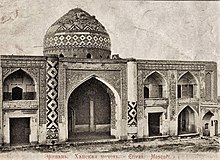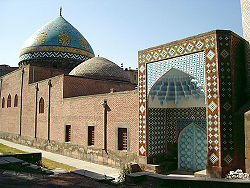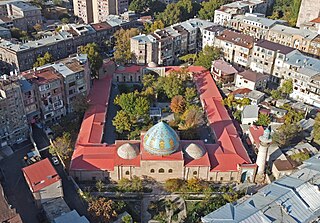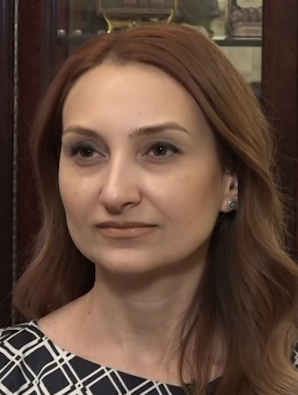
The following is a list of mosques found within the territory of modern Armenia.

The following is a list of mosques found within the territory of modern Armenia.

According to the 1870 publication of the Caucasian Calendar, a statistical report published by the Russian Viceroyalty of the Caucasus, there were a total of 269 Shia mosques in Erivan Governorate, a territory which today which comprises most of central Armenia, the Iğdır Province of Turkey, and the Nakhichevan exclave of Azerbaijan. [1]
According to Brockhaus and Efron Encyclopedic Dictionary , by the turn of the twentieth century, the population of Erivan (modern Yerevan), center of the Erivan Governorate, was over 29,000; of this number 49% were "Aderbeydzhani Tatars" (modern Azerbaijanis), 48% were Armenians and 2% were Russians, and there were seven Shia mosques in Erivan. [2] According to the traveler H. F. B. Lynch, the city of Erivan was about 50% Armenian and 50% Muslim in the early 1890s. [3] H. F. B. Lynch thought that some among the Muslims were Persians when he visited the city within the same decade. [4] According to modern historians George Bournoutian and Robert H. Hewsen, however, Lynch thought many were Persian. [5]

After the capture of Yerevan by Russians as a result of the Russo-Persian War, the main mosque in the city fortress, built by Turks in 1582, was converted to an Orthodox church under the orders of the Russian commander, General Ivan Paskevich. The church was sanctified on December 6, 1827, and named the Church of the Intercession of the Holy Mother of God. [6]
According to Ivan Chopin, there were eight mosques in Yerevan in the middle of the nineteenth century:
After 1917, many of the city's religious buildings were demolished in accordance with the Soviet government's modernization and anti-religious policies. The campaign saw the demolishment of churches, mosques, and the only synagogue in the city. [9] According to the journalists Robert Cullen and Thomas de Waal, a few residents of Vardanants Street recall a small mosque being demolished in 1990. [10] [11] In 1988–1994 the overwhelming majority of the Muslim population, consisting of Azeris and Muslim Kurds,[ citation needed ] fled the country as a result of the First Nagorno-Karabakh War and the ongoing conflict between Armenia and Azerbaijan.

The Ganja Khanate was a khanate under Iranian suzerainty, which controlled the town of Ganja and its surroundings, now located in present-day Azerbaijan.

The Nakhichevan Khanate was a khanate under Iranian suzerainty, which controlled the city of Nakhichevan and its surroundings from 1747 to 1828.

The Erivan Khanate, also known as Chokhur-e Sa'd, was a khanate that was established in Afsharid Iran in the 18th century. It covered an area of roughly 19,500 km2, and corresponded to most of present-day central Armenia, the Iğdır Province and the Kars Province's Kağızman district in present-day Turkey and the Sharur and Sadarak districts of the Nakhchivan Autonomous Republic of present-day Azerbaijan.

Мelik was a hereditary Armenian noble title used in Eastern Armenia from the Late Middle Ages until the nineteenth century. The meliks represented some of the last remnants of the old Armenian nobility. The most prominent and powerful meliks were those of Karabagh (Artsakh) and Syunik, which ruled autonomous or semi-autonomous principalities known as melikdoms under Iranian suzerainty. Meliks also existed in Yerevan, Nakhichevan, Sevan, Lori, Northwestern Persia, and other areas, although outside of Karabagh and Syunik most were merely hereditary leaders of local Armenian communities, not rulers of principalities.

The Armenian Oblast was a province (oblast) of the Caucasus Viceroyalty of the Russian Empire that existed from 1828 to 1840. It corresponded to most of present-day central Armenia, the Iğdır Province of Turkey, and the Nakhchivan exclave of Azerbaijan. Its administrative center was Yerevan, referred to as Erivan (Эривань) in Russian.

The Blue Mosque is an 18th-century Shia mosque in Yerevan, Armenia. It was commissioned by Hoseyn Ali Khan, the khan of the Iranian Erivan Khanate. It is one of the oldest extant structures in central Yerevan and the most significant structure from the city's Iranian period. It was the largest of the eight mosques of Yerevan in the 19th century and is the only active mosque in Armenia today.

The Erivan Governorate was a province (guberniya) of the Caucasus Viceroyalty of the Russian Empire, with its centеr in Erivan. Its area was 27,830 sq. kilometеrs, roughly corresponding to what is now most of central Armenia, the Iğdır Province of Turkey, and the Nakhchivan exclave of Azerbaijan. At the end of the 19th century, it bordered the Tiflis Governorate to the north, the Elizavetpol Governorate to the east, the Kars Oblast to the west, and Persia and the Ottoman Empire to the south. Mount Ararat and the fertile Ararat Valley were included in the center of the province.

Azerbaijanis in Armenia numbered 29 people according to the 2001 census of Armenia. Although they have previously been the biggest minority in the country according to 1831–1989 censuses, they are virtually non-existent since 1988–1991 when most fled or were forced out of the country as a result of the tensions of the First Nagorno-Karabakh War to neighboring Azerbaijan. The UNHCR estimates that the current population of Azerbaijanis in Armenia to be somewhere between 30 and a few hundred people, with most of them living in rural areas as members of mixed couples, as well as elderly or sick. Most of them are reported to have changed their names to maintain a low profile to avoid discrimination.

Drakhtik is a village in the Shoghakat Municipality of the Gegharkunik Province of Armenia.

Hayanist is a village in the Masis Municipality of the Ararat Province of Armenia. The distance from Yerevan is 15.4 km. Despite the favourable location of the community, most households cannot provide for their living and heads of families often chose the labour migration as the only solution of their problems. Around 160 hectares of the community's agricultural land are not irrigated.

Shurnukh is a village in the Goris Municipality of the Syunik Province in Armenia.
Zorakert is a village in the Amasia Municipality of the Shirak Province of Armenia.

Askeran is a town in the Khojaly District of Azerbaijan. Prior to the 2023 Azerbaijani offensive, it was de facto in the Republic of Artsakh as the administrative centre of its Askeran Province. It is located on the left bank of the Karkar River (Qarqarçay), approximately 11 kilometres (7 mi) northeast of the regional capital, Stepanakert.

Lev is a village in the Kalbajar District of Azerbaijan. The medieval Armenian Handaberd fortress and monastery are located near the village.

Erivan Fortress or Yerevan Fortress was a 16th-century fortress in Yerevan.

Western Azerbaijan is an irredentist political concept that is used in the Republic of Azerbaijan mostly to refer to the territory of the Republic of Armenia. Azerbaijani officials claim that the territory of the modern Armenian republic were lands that once belonged to Azerbaijanis. Its claims are primarily hinged over the contention that the current Armenian territory was under the rule of various Turkic tribes, empires and khanates from the Late Middle Ages until the Treaty of Turkmenchay (1828) signed after the Russo-Persian War of 1826–1828. The concept has received official endorsement by the government of Azerbaijan, and has been used by its current president, Ilham Aliyev, who, since around 2010, has made regular reference to "Irevan" (Yerevan), "Göyçə" and "Zangazur" (Syunik) as once and future "Azerbaijani lands". The irredentist concept of "Western Azerbaijan" is associated with other irredentist claims promoted by Azerbaijani officials and academics, including the "Goycha-Zangazur Republic" and the "Republic of Irevan."

Vank or Vangli is a village in the Kalbajar District of Azerbaijan, in the region of Nagorno-Karabakh. The village had an Armenian majority in 1989. The 13th-century Gandzasar Monastery, and the 9th-century Khokhanaberd fortress are located near Vank.
Mark Grigorian was a Soviet Armenian Neoclassical architect.

Lilit Kamo Makunts is an Armenian philologist and politician who currently serves as the Armenian ambassador to the United States. Earlier, she served as the leader of the ruling My Step Alliance faction in the seventh National Assembly of Armenia and as Minister of Culture in the first cabinet of Nikol Pashinyan.

Akob Aghi khachkar is a khachkar located just northeast of the village of Hayravank along the southwest shores of Lake Sevan in the Gegharkunik Province of Armenia. It lies in front of the western wall of the Hayravank Monastery complex, on the pedestal; the upper left corner is broken. It is included in the state list of immovable monuments of history and culture of Armenia (5.59/1.1.3.5)։ The khachkar was created by Akob, a 16th-century Armenian sculptor, maker of khachkars and tombstones.